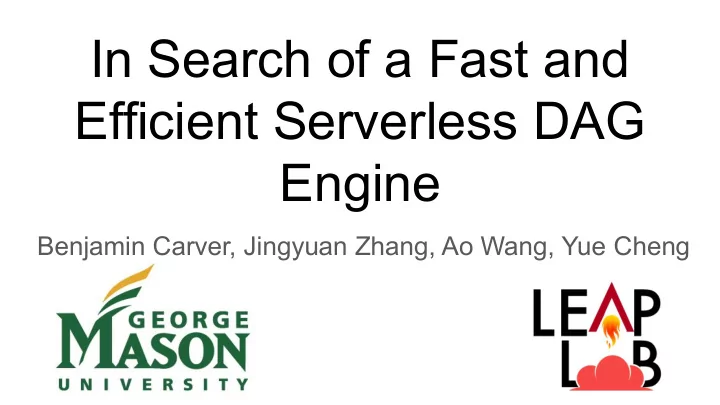

In Search of a Fast and Efficient Serverless DAG Engine Benjamin Carver, Jingyuan Zhang, Ao Wang, Yue Cheng
Serverless Computing ● Emerging cloud computing platform based on the composition of fine-grained user-defined functions ● Service provider is responsible for provisioning, scaling, and managing resources ● Pay-per-use pricing model with fine granularity 2
Background ● Data analytics applications can be modeled as a directed acyclic graph (DAG) based workflow ○ Nodes: fine-grained tasks ○ Edges: dependencies between tasks, often large fan-outs ● DAG workflows well-suited for serverless computing (or Functions-as-a-Service) ○ Auto-scaling accommodates short tasks and bursty workloads ○ Pay-per-use keeps the cost of short tasks low 3
From Serverful to Serverless ● Serverful focuses on load balancing and cluster utilization ○ Bounded resources, unlimited time ○ User explicitly allocates tasks to processors ○ Servers managed by the user ● Serverless platforms provide a nearly unbounded amount of ephemeral resources ○ Bounded time, unlimited resources ○ Cloud provider automatically allocates serverless functions to VMs ○ Servers managed by the service provider 4
AWS Lambda Constraints ● Lambda function invocation currently take 50ms on average ● Outbound-only network connectivity ● Relatively low network bandwidth ● Execution time limits (900 seconds) ● Lack of quality-of-service (QoS) control, leading to stragglers ○ e.g., cold starts 5
Existing Parallel Frameworks Using Serverless Computing ● PyWren [SoCC’17] ○ Parallelize existing Python code with AWS Lambda ● Numpywren ○ System for linear algebra built atop PyWren ● ExCamera [NSDI’17] ○ System which allows users to edit, transform, and encode videos using fine-grained serverless functions ● gg [ATC’19] ○ Framework and command-line tools to execute “everyday applications” within cloud functions 6
Typical Approaches ● Approach 1: Queue-based Master-Worker ○ Master submits ready tasks to a queue ○ Workers are cloud functions that process tasks in parallel, e.g., Numpywren ○ Drawbacks : cannot exploit data locality as easily; reading from queue could become a bottleneck ● Approach 2: Centralized scheduler directly invokes cloud functions to process ready tasks, e.g., ExCamera ○ Drawback : centralized scheduler could become a bottleneck for system 7
Typical Approaches ● Approach 1: Queue-based Master-Worker ○ Master submits ready tasks to a queue ○ Workers are cloud functions that process tasks in parallel, e.g., Numpywren ○ Drawbacks : cannot exploit data locality as easily; Wukong solves these drawbacks. reading from queue could become a bottleneck ● Approach 2: Centralized scheduler directly invokes cloud functions to process ready tasks, e.g., ExCamera ○ Drawback : centralized scheduler could become a bottleneck for system 8
Wukong Approach ● ● Architecture ○ Static Scheduler ○ Task Executors ○ Storage Manager ● Evaluation 9
Task executors cooperate here! Our Approach - Wukong Static Scheduling Dynamic Scheduling ● Statically partition DAG into sub-DAGs ● Decentralized, cooperative scheduling ○ Assign each partition to a Lambda function ○ Lambda functions coordinate with each other to execute overlapping sections of 10 assigned sub-DAGs
Wukong ● Approach ● Architecture ○ Static Scheduler ○ Task Executors ○ Storage Manager ● Evaluation 11
12
Static Scheduler ● Partitions DAG into sub-DAG using a depth-first search (DFS) from each leaf node. ● Assigns sub-DAGs to executors 13
Executors ● Decentralized, cooperating schedulers ● Schedule and execute tasks in assigned sub-DAGs ● Cooperate on scheduling tasks contained in two or more sub-DAGs 14
Storage Manager ● Performs storage operations on behalf of Executors and Static Scheduler ● Using KV Store for intermediate data storage 15
Wukong ● Approach ● Architecture ○ Static Scheduler ○ Task Executors ○ Storage Manager Evaluation ● 16
Experimental Goals ● Identify and describe the factors influencing performance and scalability ● Compare W UKONG against Dask ○ Can W UKONG achieve performance comparable to Dask distributed executing on general-purpose VMs, given the inherent limitations of AWS Lambda? 17
Experimental Setup ● Compare against Dask distributed running on two different setups. ○ 5-node EC2 cluster of t2.2xlarge VMs ○ Laptop ■ Windows 7 64-bit ■ Intel Core i5-6200U CPU @ 2.30GHz ■ 8GB RAM ● Wukong Static Scheduler, KV Store, and KV Store Proxy running on c5.18xlarge EC2 VMs. ● Task Executor allocated 3GB memory with timeout set to two minutes. 18
Four DAG Applications ● Microbenchmark ○ Tree Reduction : repeatedly add adjacent elements of an array until a single value remains ● Linear Algebra ○ General Matrix Multiplication (GEMM) ■ 10,000 × 10,000 and 25,000 × 25,000 ○ Singular Value Decomposition (SVD) ■ n × n matrix and a tall-and-skinny matrix, varying sizes ● Machine Learning ○ Support Vector Classification (SVC) ■ 100,000 - 800,000 samples 19
Tree Reduction 20
Tree Reduction with Delays 21
General Matrix Multiplication (GEMM) and Support Vector Classification (SVC) GEMM SVC 22
Singular Value Decomposition (SVD) - “Tall and Skinny” SVD tall-and-skinny X = da.random.random((200000, 100), chunks=(10000, 100)) u, s, v = da.linalg.svd(X) v.compute() # Begin execution 23
Singular Value Decomposition - “ n × n ” SVD-Compressed (rank 5) n × n X = da.random.random((10000, 10000), chunks=(2000, 2000)) u, s, v = da.linalg.svd_compressed(X, k=5) v.compute() # Begin execution 24
Factors Influencing Performance 25
Conclusion ● Serverless platform introduces unique challenges and opportunities ● Decentralization provides a large performance increase ○ Data locality and minimizing network overhead are also important to performance ● W UKONG achieves performance comparable to serverful Dask distributed running on general-purpose EC2 VMs ○ Improves performance by as much as 3.1 X as problem size increases 26
Thank you! Questions? Contact: Benjamin Carver - bcarver2@gmu.edu GitHub: https://github.com/mason-leap-lab/Wukong 27
SVD 50,000 × 50,000 CDF Plot 28
SVD n × n with “ideal storage” 29
SVD Phase #2 10k x 10k 25k x 25k 50k x 50k 100k x 100k 256k x 256k [2k x 2k] [2k x 2k] [5k x 5k] [5k x 5k] [5k x 5k] NumPaths 95 565 345 1309 8376 NumTasks 172 800 507 1727 10509 NumLambdas ~84 ~480 ~295 ~1082 8267 to 10511 LeafTasks 30 182 110 420 2756 SVD Phase #1 200k x 100 [10k x 100] NumPaths 20 NumTasks 42 NumLambdas ~20 LeafTasks 20 30
31
Recommend
More recommend